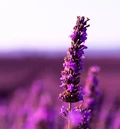
Scientists at the CSIR-Indian Institute of Integrative Medicine in Jammu are making significant progress in their study of lavender, a flowering plant that has sparked what is now known as the 'purple revolution' in the region.
The institute is specifically focusing on the residue left behind after the extraction of lavender oil, which is obtained through a steam distillation process called 'marc'. This research has the potential to revolutionize the lavender farming industry and benefit the local farmers.
Currently, lavender oil sells for approximately Rs 10,000 per liter, making it a lucrative crop for farmers in the region. However, the scientists at CSIR-IIIM are now concentrating on value-addition interventions and studying the waste produced during the oil extraction process. By exploring the potential uses of this waste material, they hope to create new avenues of income for the farmers and extract additional value from the lavender plants.
Director Zabeer Ahmed explained that they were attempting to isolate and characterize the molecules found in the marc. He mentioned that their scientists had already discovered a few new molecules, and they were currently conducting bioactivity tests to evaluate their potential, including anti-cancer activity. He further stated that the research findings on the marc held significant promise for the future.
If the health benefits of the marc are proven effective, it could open up new opportunities for farmers to generate revenue. In addition to lavender oil, the steam distillation process also produces hydrosol, lavender-scented water that can be used in various products such as room sprays, bathroom fresheners, and body sprays. Even the dried stalks of lavender flowers have a good market due to their long-lasting fragrance, which can persist for up to two years.
Aroma mission has been successful in promoting lavender farming among the local farmers in this picturesque town, situated amidst the Sonbain and Ashapati glaciers of the Himalayan ranges. In addition to lavender, the Aroma Mission focuses on scientific research and development in the cultivation of other aromatic plants such as rose, lemon grass, rosemary, and wild marigold. The CSIR laboratories involved in the mission provide small and marginal farmers with free quality planting material, further supporting their involvement in the aromatic plant industry.
The collaboration between CSIR-IIIM and CSIR-Indian Institute of Chemical Technology in Hyderabad is another crucial aspect of the research. The two institutes are jointly studying the potential use of lavender oil in treating sleep disorders, further expanding the scope of lavender's medicinal applications.
As the 'purple revolution' gains momentum in the region, the efforts of the scientists at CSIR-IIIM and their partners hold the promise of transforming the lives of farmers in Lavender Valley. With their innovative research and value-addition interventions, they aim to unlock the untapped potential of lavender, creating new avenues of income and improving the overall economic prospects of the local farming community.
















